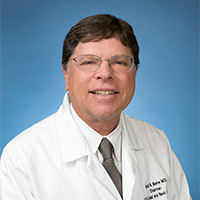
Dysphonia International hosted a half-day virtual Research Grantee Workshop on November 3, 2023. It included a number of Dysphonia International-funded investigators, all of whom are studying spasmodic dysphonia, a form of laryngeal dystonia. The overall concept for the meeting was for these researchers to identify areas of commonality and discrepancies in their conceptual framework regarding the cause or causes of spasmodic dysphonia. We wanted to explore these various approaches and increase the collaboration amongst our investigators, as much of the currently funded research could complement another grant. Dr. Gerald Berke (pictured), the Chair of the Scientific Advisory Board, moderated the meeting and prepared the summary below that provides an overview of the participant’s research.
Dr. Scott Norris studies functional MRI of patients with spasmodic dysphonia and has determined that previous functional MRI studies did not properly synchronize their imaging, thus creating false impressions of areas of the brain that were implicated in the disorder. As with many of the researchers, Dr. Norris pointed out there continues to be a functional connectivity issue in patients with spasmodic dysphonia affecting the basal ganglia, cerebellum, thalamus and cerebral cortex. Patients also seem to have a somatosensory dysfunction, which we will go into more detail on below.
Dr. Jürgen Konczak has developed a vibrational stimulator which, when placed on the patient’s neck and with repeated use over time, induces much more regularity of voice with loss of strain strangled perception and voice breaks for up to one hour following the wearing of the collar. The thought is that the vibration of the collar somehow interferes with the somatosensory dysfunction going to the brain which has some lasting effects.
In a similar manner, Dr. Michael Hammer has been using airflow puffs to the laryngeal structures of varying intensities and has shown that patients with SD demonstrate differences from normal individuals in their responsiveness to sensory information, which again highlights dysfunction in somatosensory control.
Dr. Teresa Kimberley has been studying the effect of trans-magnetic stimulation (TMS) on areas of the speech center as a means of classifying as well as possible treatment of patients with spasmodic dysphonia. Her studies have demonstrated that there is an inhibitory center that communicates and modulates the excitatory center in the cortical area of the brain that controls speech. There seems to be a communication defect that has occurred in patients with spasmodic dysphonia. The inhibitory centers have somatosensory information coming into them but are unable to successfully modulate the excitatory centers in the brain.
Of significant interest in her studies is that she has demonstrated that the inhibitory area is much more active in patients with spasmodic dysphonia, possibly indicating that the body is overcompensating for its inability to control speech center excitation properly. With respect to trans-magnetic stimulation treatment, it is still in its early stages but does show at least some short-term promise to improve the condition.
Dr. Michael Pitman worked to validate a patient-reported outcomes tool called the Communication Item Participation Bank in an effort to improve the evaluation of the severity of symptoms of patients with SD. This is an important objective as there are very few standardized systems to evaluate severity currently, which is necessary to provide information on the efficacy of treatment and comparison across research institutions. In addition, Dr Pitman has developed a laryngeal nerve stimulator which, when applied to the recurrent laryngeal nerve, can interrupt aberrant neurologic signals for a period of time. However, the positive results are currently short-lived.
Dr. John Houde and his team utilize magnetoencephalography (MEG) to observe neuro activity during speech with people with SD and those with SD and vocal tremor. This is another important study that demonstrates that auditory feedback, as well as sensory information from receptors in the speech system, contribute greatly to alterations in voice and speech in patients with spasmodic dysphonia.
It is apparent from the discussion at this seminar that patients with spasmodic dysphonia demonstrate a somatosensory defect in their ability to control the excitatory function of the cortical speech center and in other areas of the brain. Specifically, why this is occurring, whether it is a chemical imbalance or a structural defect, is a subject of ongoing research.
Dysphonia International was very pleased to see the interaction and interest among the attending researchers. All in attendance were supportive and appreciative of the suggestion to continue discussions with additional workshops in the future. We appreciate the commitment of our researchers in seeking answers to enhance our understanding of spasmodic dysphonia and related voice conditions, ultimately striving to discover a cure.


